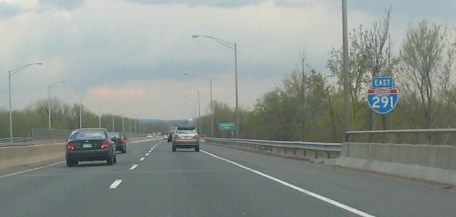Updated Oct 20, 2018
The Bissell Bridge, carrying Interstate 291 across the Connecticut River north of Hartford, connects Windsor to South Windsor. Built in 1957 as part of a planned Hartford beltway, it was fully connected to area freeways when I-291 was completed in 1994.
 I-291 eastbound, approaching Bissell Bridge, Windsor. Photo taken April 2004 by Kurumi.
I-291 eastbound, approaching Bissell Bridge, Windsor. Photo taken April 2004 by Kurumi.
The bridge is about 1,680 feet long with 14 spans. It carries four lanes of traffic width a bicycle path on the north side.
I don't have any photos of the bridge yet. Its flat profile is entirely unremarkable to the driver. Riverside trails or watercraft provide the best vantage point.
In the first decades of the 20th century, the Bulkeley Bridge, which today carries Interstate 84, was the only Connecticut River bridge between Middletown and Warehouse Point. As traffic increased, the six-lane bridge became a regional bottleneck; and when the river flooded, its low-lying approaches often had to be closed.
In the early 1930s, State Highway Commissioner John A. MacDonald articulated the need for additional bridges in the Hartford area, to the north and south. A 1932 plan for extending the Merritt Parkway northeasterly to Massachusetts included split routes over two bridges, one at South Glastonbury and one very near where the Bissell is now.
The Merritt Parkway extension (later the Wilbur Cross Parkway) and its two bridges did not materialize north of Meriden as planned. However, the state continued with newer plans to cross the Connecticut River. The Charter Oak Bridge (US 5/CT 15), built in 1942, helped divert traffic, but by the end of the 1940s congestion on the Bulkeley Bridge had risen again.
In 1955, Governor Abraham Ribicoff established the Greater Hartford Bridge Authority, in order to devise a multi-bridge plan for the Hartford region. The Authority was responsible for the planned Bissell Bridge, along with the new Putnam and Bissell Bridges, and tolls on the Charter Oak and Bulkeley bridges. Its duties were turned over to the state highway commissioner in 1959, after all three new bridges were built.
Meanwhile, the state was planning an interstate bypass for Hartford, which gained the designation I-291 in 1957. Originally the designation did not continue east of I-91, though a state highway from Windsor to Manchester was contemplated.
The Bissell Bridge opened on Dec. 16, 1957. A four-lane divided highway with at-grade intersections led westerly to a diamond interchange at I-91. A four-lane freeway led easterly to terminate at a half-diamond interchange at US 5. Preparation was made for a full cloverleaf there when the freeway, to be part of an extended I-291, was finally completed.
The bridge charged a toll from its opening until Oct. 9, 1985, when as a result of a tollbooth accident on I-95 Gov. William A. O'Neill ordered tolls removed on both I-95 and the Bissell Bridge.
The original name was the South Windsor Bridge, or the Wolcott Bridge, for the Wolcott Avenue connector to it. On September 9, 1960, it was dedicated to Capt. John Bissell, captain of the Connecticut Troops from 1657 to 1676, who led the settlement of the Windsor area.
For a few decades, the Bissell Bridge carried state route 291, which was marked from I-91 to US 5.
Through the 1970s, each segment of I-291 west of I-91 was cancelled. However, the portion from Windsor to Manchester was revived, as part of an $800 million reconstruction of I-91 in the late 1980s and early 1990s. I-291 was extended to US 5 in 1992, and completed in 1994. Included in the project was a complete replacement of the Bissell Bridge superstructure.